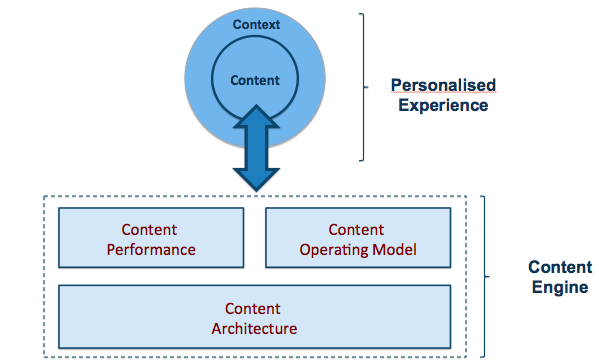- Content Engine Explained
- Content Engine Blueprint
- Content Engine Operationalisation
If we can address the content challenges that exist within brands, what opportunities can organisations capitalise on now to deliver personalised experiences? We asked that question to a mix of agencies, brands and partners that attended a WPP European Summit back in June 2015. Here’s what our summit delegates prioritised as the three key areas for serious consideration by the business. In this post, we’ve pulled them together into a draft content engine blueprint:
- Show tangible business value and success. Understanding what content exists within the enterprise. Continually show its value, impact, and return back into the business. What if they was a workable content performance framework that continuously linked and tracked the investment case for content as a practical and pragmatic set of KPIs and objectives that quantified success? Imagine that.
- Manage content as a product. Move beyond episodic campaigns and projects. Focus on assembling brand communications, using blocks of reusable content that’s accessible across the enterprise. What if content architecture applied end-to-end product management principles to the design of strategic content, from ideation to expiration, based upon transparent and agreed investment cases? Imagine that.
- Content lifecycle management. There needs to be clear separation between content products and the services people use to operate them. What if the content operating model surfaced the processes and overarching governance framework for getting content into and out of the enterprise to drive real-time personalised experiences? Imagine that.
Forrester predicts that the volume of unstructured enterprise content is growing at a rate of 200% annually. Content is communication. How well it is designed, managed and measured directly impacts on our ability to engage effectively with customers. The content engine looks to address our content challenges and turn them into opportunities by consciously stepping up to manage content as an enterprise-level strategic asset that drives competitive advantage.
Content Engine Blueprint
A conversation is a two-way communication. This requires the content engine to both produce and consume content. If all incoming communications from the consumer to the business are personalised, then that sets the bar extremely high for a meaningful outgoing response from the business to back to the consumer. Personalised experiences should be the default mode of engagement but we are making do today with a lot less.
The content engine is comprised of three inter-connected parts required to deliver repeatable, predictable and scaleable content that drive personalised experiences. I’m sure there are many more parts, but these three form the core:
Content Performance
We seldom quantify the value of content in business terms. Instead, we see those people that work closely with content struggling to tell a story that resonates within an executive agenda. Worst still, it’s too difficult to track and measure content performance over time against unclear and moving business goals.
Time for an example. I’m a news editor. I have two days of journalist’s time to publish an article to address a local market ask. What KPIs and objectives would help me determine the optimal content to get the best return on my investment? I worked with one publisher that armed its editors with meaningful editorial intelligence. They knew precisely how long their journalists took to create articles. The global reach of all published articles. The level of reader engagement. The amount of article references, referrals and retweets. All the stats in near realtime. As such, they could select the best journalist for the task at hand. Content performance is critical to drive informed business decisions about which journalists are best position to create value in specific circumstances.
Content Architecture
We have to design for content in order for it to be business ready. We rarely afford the time to structure content so that its modular, self-describing and channel agnostic. These are the essential characteristics of scaleable content. We need content to scale. To dissemble and reassemble content for use in different contexts, different channels, different consumers, to communicate in highly personalised ways.
However, in the absence of a performance model for content that maps directly back to business value, it’s difficult to make informed investment decisions around the design of content. How reusable should the content be? What level of granularity should we break up the content into? How many channels and over what period of time should we design the content to be accessible for? In the absence of business purpose and performance, all we can do is guess. So we continue to fire more bullets into the dark, trying to make content more intelligent, but without a target in sight. This is a very expensive exercise if left to chance.
Hence, content performance and content architecture are connected. We must start with content performance to help scope, score and define success for content architecture. Then, when that’s up and running, content architecture adapts based upon continuous feedback gleaned from content performance. Performance helps provide the guide rails for architectural activities.
Content Operating Model
If performance is the why, architecture the what, then the operating model is the how.
We need an operating model that details the end to end processes people follow to make content repeatable and predictable. However, before moving forwards, let’s take a couple of steps back to understand your existing processes. Most organisations don’t do this for a very good reason. They cannot describe their existing processes. Moreover, they don’t have the time, inclination and/or skills to understand the as-is state. So why bother?
Tempting as it is, you need to understand your current operating model before forging a new one. The existing processes have value today and before you go on “mission improvement”, consider the following:
- Just because something is possible doesn’t mean that it’s profitable. There is no point designing new processes that cost more to run and operate in a new digital world. How would you know this without understanding your existing processes?
- Engineering 101; if it ain’t broken, don’t fix it. If the existing processes work, why bother changing them? Show the value in the new processes by comparing against the current processes.
The future operating model takes into consideration new capabilities afforded by a content architecture that delivers raw, modular and self-describing scaleable content. The operating model brings repeatable and predictable processes that encapsulates the full end-to-end content management lifecycle.
Summary
Our content engine blueprint pulls together three key parts:
- Performance to continually define and measure success.
- Architecture that structures scaleable content.
- Operating model that describes a set of processes for performing the tasks required across the entire content management lifecycle in a repeatable and predictable manner.
The content engine is not a technology. It’s a blueprint. That leads us to our final question. How would you go about operationalising a content engine within your organisation?



Pingback: Content Engine Explained - Cleve Gibbon
Pingback: Content Engine Operationalisation - Cleve Gibbon